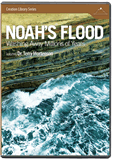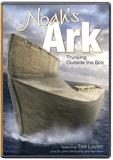Readers Respond to Answers April - June 2007
Share Answers
I thoroughly enjoyed your Noah’s Flood special issue. We will surely pass this one around for everyone in the family to read, then keep it on our shelves for future reference! I like the article length in your magazine, as well as the varying technicality levels. Thank you, and I will continue to pray for your ministry.
—Michelle Sturgeon, El Paso, IL
Teaching Tool
I was getting ready to go out to a school assembly this morning when I received my mail with the latest Answers magazine included. I was greatly surprised and very much delighted to see the front cover and pullout dealing with Noah’s Flood, the very story I had prepared to tell the children. I took the pullout with me, and the teachers have agreed to pass it around the various classes to let the children look at it firsthand. I thought to myself that God is so good and this material will really bring the reality of the story home to the boys and girls.
—William Leonard, Omagh, Northern Ireland
Scripture First
The April–June 2007 issue of Answers was exceptional. “Thinking Outside the Box” by Tim Lovett challenged me the most. It opened my eyes to a whole new way of thinking concerning the construction of the Ark. My only question is “Why didn’t we as Christians think of this design before?” I also want to encourage other readers not to approach new ideas with skepticism, as I did, but instead, open your mind to them, and put these ideas to the ultimate test: the Bible. In the case of the “New Ark Concept,” every last detail lines up with Scripture!
—Joel Sonntag, Middlebury, IN
Fun Quizzes
I think Kids Answers is great! I think the quizzes are a super-great way to educate kids and get them interested in learning. The facts you give are great.
—Lauren Glenn, 11 years old, Beaumont, TX
Questions Answered
Thank you for your magazine. As a new Christian I had many questions and doubts in my head regarding evolution and such. Your magazine helps answer these questions and gives me such a security that I can trust the Bible to be the infallible truth.
—Heather Hoog, Rockledge, FL
A Super BreakUp
Dr. Snelling’s article on catastrophic plate tectonics presented some interesting and thought-provoking ideas. If the breakup initiated the release of subterranean water and the subsequent flooding, then the massive deposition of sediments would have occurred after the plates had already moved and continents split apart (being rapid).
However, the geological evidence from Argentina, South Africa, and Antarctica implies the thick sediments were deposited onto a supercontinent before the continents broke apart. Fossil-bearing, alternating sedimentary layers can be accurately correlated across all three continents.
I would love to hear Dr. Snelling’s explanations for the timing of catastrophic plate tectonics, taking into account evidence such as this.
—Graham Armitage, Nottingham, NH
Author’s Response: The supercontinent Pangaea probably assembled midway through the Flood. It is possible that a previous supercontinent Rodinia actually represented the pre-Flood supercontinent, assuming there was such a thing. We think Rodinia probably came apart early in the Flood, with its pieces slamming back into each other later in the Flood, forming a mostly submerged Pangaea.
Pangaea then came apart and emerged near the end of the Flood, with its pieces forming today’s continents. It’s difficult to piece all of this together, especially from Pangaea backward. Thick sediments, blanketing underwater continents, would have been produced and deposited during this whole time. In fact, those are what help us piece together some of the timing.
Dr. John Whitmore
Note: Dr. John Whitmore, Associate Professor of Geology at Cedarville University, responded since Dr. Andrew Snelling was out of the country at press time.
The Ark and Weathervanes
I received my magazine from AiG today and was impressed by the coverage based on Noah’s Ark. However, I am puzzled by their insistence that the “fin” atop the bow would use wind to keep the ship headed into the waves. I could understand this if the fin were on the stern; to me that’s why weathervanes have their fin at the rear. Am I missing something?
—F.M. Arehart, Boise, Idaho
Author’s Response: Deciding which end to call bow or stern on the Ark is somewhat arbitrary since it is a drifting vessel. Normally a ship would want to have the bow to the weather, which is what we are familiar with. We could easily swap the names bow and stern, but there are two reasons I chose to call the sail side the bow and the protruding skeg the stern:
1. It is in keeping with the direction of travel of the Ark. (Moving the same way as the bow is pointing) See www.worldwideflood.com/ark/anti_broaching/bow_fin.htm.
2. Very ancient ships are depicted this way (“mysterious” stern protrusions as opposed to much later Greek ramming bow protrusions). The earliest ships had protrusions at the stern, which is why it is considered a mystery. Perhaps there is a reason for this. See www.worldwideflood.com/ark/hull_form/ancient_hull_form.htm.
Tim Lovett
Answers for Small Group
I’ve been anticipating this coming issue for over a month, after having seen your promotional cover picture and because my small group is currently addressing questions posed to us by a nonbeliever that often as not center on the validity of the Ark and a young earth.
I just received the magazine today and after reading some of the articles online and then going through the over 100-page magazine this evening, I just wanted to tell you I think this issue is phenomenal! The articles, authors, graphics, and quality are a tour de force. The combined analysis of the Ark, Flood, geologic forces, weather effects, and anthropology are a compelling summary of the field. I really think I might buy 10 or more copies to spread around.
—Matt Caldwell, West Sacramento, CA
Science and Seaworthiness of the Ark
I really enjoyed the special issue of Answers magazine on Noah’s Flood. I was very intrigued by Tim Lovett’s thoughts on the design of the Ark—fascinating! One thing I appreciated most was the insert on page 27: “Scientific Study Endorses Seaworthiness of Ark.” Please continue to include such scientific findings that bolster the trustworthiness of the biblical record.
—Jeff and Sarah Stoller, New Haven, IN
Recommended Resources

Answers in Genesis is an apologetics ministry, dedicated to helping Christians defend their faith and proclaim the good news of Jesus Christ.
- Customer Service 800.778.3390
- © 2024 Answers in Genesis




